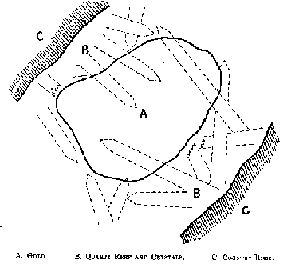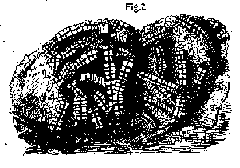|
Benjamin
Dunstan -
Some extracts from
his journals |
|
By Tony Forsyth
After Robert L. Jack, the most influential person in
Queensland mineralogy was probably Benjamin Dunstan. Working for the Geological Survey of
Queensland since before the turn of the century, Dunstan rose to head the Survey for over
two decades. He is credited with publishing many important reports, with a keen eye for
the unusual and a genuine love of minerals. He was also a fine draftsman, and his
illustrations contained in the reports are particularly detailed.
His major work the ‘Queensland Mineral Index’
published in 1913, is still a standard text today, and is not likely to be matched,
listing over 18,000 entries of mineral occurences around the state. Here are two
illustrated excerpts from reports written in 1904 and 1905, obtained from the the
Department of Minerals and Energy Library.
Dee River Nugget
Last century much debate occurred amongst the mining fraternity on the origin of gold
nuggets. Were they deposited and built up to a lump from the fine grounds of gold in the
streams, did they precipitate from solutions or did they merely erode from larger gold
specimens and were waterworn?
Benjamin Dunstan seemed to have an answer when a large
nugget was discovered in the Dee River not far from Mount Morgan near Rockhampton in
Central Queensland.
| "...the evidence on
this point showed conclusively that the gold had formed in association with quartz. The
85½ oz. nugget, on examination besides showing a frosted surface, was found to be
penetrated by a number of six-sided holes. On closer inspection, after the specimen was
cleaned, these holes proved to be the casts of quartz crystals, in which all the well
known peculiarities of crystallisation of that mineral were reproduced, showing
undoubtedly the gold to have been deposited in a vugh or cavity containing a cluster of
quartz crystals. The following rough sketch will show how the gold occurred, and from it
the conclusion will be drawn that the size and shape of the gold nuggets were very
different when enclosed in the cavity of quartz crystals from what they were when found in
the alluvial wash, after being worn into their present form by attrition". |
 Extract from the
Geological Survey of Queensland Publication
No. 190, Records No. 1, By B. Dunstan
(Acting Government Geologist) 1904 |
Selected Mineral
Notes
Calcite Crystals with Pyrites
Inclusions, at Golden Gate, Croydon
In the block shaft being sunk at Roger’s Extended Mine, on the Golden Gate line of
reef at Croydon, a quartz reef has changed into calcite, in the cavities of which calcite
crystals have been formed.
| "Figure 2, Plate 5,
shows the general appearance of the crystals as they appear in groups, with the lines of
pyrites inclusions passing through them. Figure 1, on the same plate, illustrates the
character of the twinning, the pyrites dust inclusions on the terminal faces, and the
median line of microscopic crystals of pyrites traversing the group of calcite crystals at
right angles with the principal axis". |

Figure 1. |

Figure 2. |
Gypsum Twin Crystals at
Eukalunda, near Bowen
"Specimens of Gypsum penetration-twin crystals have been received by the
Geological Survey Office, Brisbane, from Eukalunda, near the Durham Mine, where they are
stated to occur in a formation in granite close to sedimentary rocks". |
Extract
from Geological Survey of Queensland Publication
No. 196, Records No. 2, By B. Dunstan
(Acting Government Geologist) 1905 |
 News and Articles Index News and Articles Index
 Home Page Home Page
|


